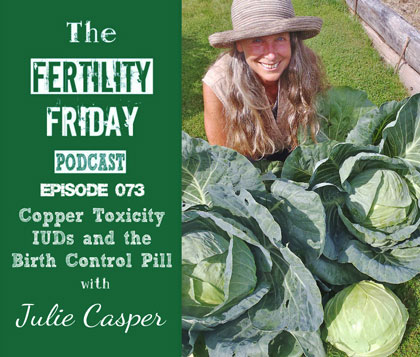Update: 19 November 2024
Copper Toxicity & Self-Evaluation
Author: Julie Casper, C. Ac.
Both copper excess and copper deficiency contribute to metabolic dysfunction. Please learn the facts before you worry (there's a lot of fear-mongering online).
Understanding Copper Toxicity
First of all, not all copper is toxic. In fact, copper is an essential trace element that is vital to the health of all living things (humans, plants, animals, and microorganisms). Copper is essential to the proper functioning of organs and metabolic processes. Copper also is an essential trace element that is required in enzyme systems, and enzymes are responsible for countless metabolic processes required to sustain life. For example, enzymes are indispensable in cellular activity for signal transduction, and cell regulation.

Fertility Friday Podcast interview with Julie Casper.
Carl Curt Pfeiffer, MD, PhD (1908 – 1988) of the Brain Biocentre in Princeton, New Jersey, conducted extensive research on copper metabolism and human health.1 His findings indicate that a high body copper burden can be responsible for disorders such as;
- hypotension,
- heart disease,
- premenstrual tension,
- postpartum depression,
- paranoid and hallucinatory schizophrenias,
- childhood hyperactivity and autism.
The human body has complex homeostatic mechanisms which attempt to ensure a constant supply of available copper, while eliminating excess copper whenever this occurs. However, like all essential elements and nutrients, too much or too little nutritional ingestion of copper can result in a corresponding condition of copper excess or deficiency in the body, each of which has its own unique set of adverse health effects.
A common source of ingested copper comes from our drinking water supplies which run through copper piping, particularly in areas where the water is soft and acidic, as this corrodes layers of copper from the pipes releasing it into drinking water. This action also occurs when acidic foods are cooked in copper pans. Cigarette smoking is another prominent source of excessive copper accumulation.2 Additionally, oral contraceptives are notorious in raising the body's copper burden due to estrogen's effects on tissue copper accumulation.
Until recently, the recognition and treatment of heavy metal excesses and trace and macro-mineral deficiencies has been hindered by a lack of reliable diagnostic techniques. Although blood, sweat and urine have been used, these have been found to be ineffective in detecting long-term exposure due to the fact that body fluids are in a constant state of flux, thereby reflecting only a very recent exposure within only hours or days. Since the development of modern laboratory techniques, trace element concentrations can now be measured from the smallest of samples with great precision and accuracy. Particularly, since the introduction of the inductively coupled plasma mass spectrometry (ICP-MS) system which has a multi-detection capacity, hair tissue mineral analysis has become the diagnostic tool of choice because it can measure the presence of nutritional and toxic trace elements reliably, and noninvasively.
- Do you have copper toxicity? Copper Toxicity Self-Evaluation
Symptoms of High Copper (Excess)
- Feelings of doom
- Fatigue and exhaustion
- Hypothyroid (slow thyroid)
- Mind is in a fog
- Headaches, migraines
- Mood swings
- Supersensitive, weepy
- Cold hands, and/or feet
- Depression
- Dry skin
- Chocolate cravings
- Feeling of loss of control
- Paranoia
- Despair, suicidal feelings, hopelessness
- Arthritis, calcium spurs
- Constipation
- Racing heart, pounding heart
- Adverse reaction to vitamins and minerals
- Problems with concentration and memory
- Short attention span
- Eating disorders: anorexia, bulimia, overeating
- Panic attacks, high anxiety, free floating anxiety
- Yeast infections (candida)
- Aching muscles or muscle cramps
- Hypoglycemia
- Insomnia, interrupted sleep
- PMS
- Mononucleosis
- Low blood pressure
- Obsessive thoughts
Symptoms of Copper Deficiency
- Anemia
- Fatigue
- Decrease in number of white blood cells
- Osteoporosis
- Nerve damage can cause tingling and loss of sensation in the feet and hands
- Confusion
- Irritability
- Depression
- Impaired Coordination
- Vitamin B12 deficiency
- Iron deficiency
- Low blood levels of fat-soluble vitamins, zinc, and folate
- Hypochromic anemia
- Neutropenia
- White, gray and silver hair
- Hemorrhoids
- Varicose veins
Related Information
References
- Mental and Elemental Nutrients., New Canaan, CT. Yeats Publishing Inc.
- Elevations in serum copper, erythrocytic copper, and ceruloplasmin concentrations in smokers, American Journal of Clinical Pathology